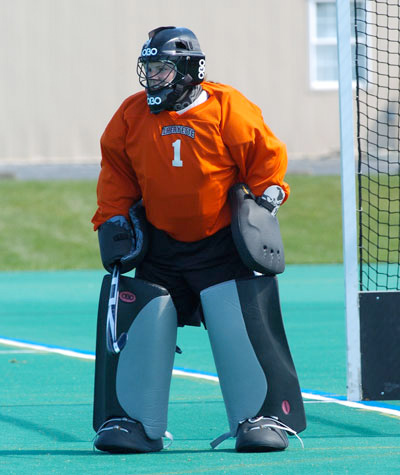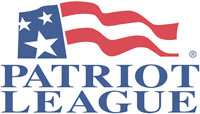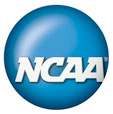Sports: Game Plan for Excellence
FOR ATHLETES, ACADEMIC SUPPORT AND SUCCESS
BY DREW KINGSLEY | PHOTOGRAPHY BY RICK SMITH
In the NCAA’s most recent report on graduation success rates at the nation’s Division I schools, released in October, Lafayette ranks No. 3, with a rate of 97 percent. Lafayette has placed among the leaders in the last several NCAA reports, consistently posting a graduation-success rate above 90 percent. The national average is in the 70-percent range.

Kelsey Andersen ’11
President Daniel H. Weiss says he is “very pleased.” But not surprised. “In an age of compromise and corruption in college athletics, Lafayette and the Patriot League have been steadfast in an enduring commitment to academics,” he says. “It’s not a bonus when our student-athletes excel academically. They are expected to thrive.”
THRIVING
Kelsey Andersen ’11 and Stefan Bauer ’11 are among the 504 Lafayette students who are varsity athletes (that’s more than one-fifth of all students). Thriving? Yes.
A four-year starter in goal, Andersen, of West Long Branch, N.J., helped lead the field hockey team to the championship game of the Patriot League tournament three times. As a junior, she was named a first-team all-star and Goalkeeper of the Year by the league and named third-team All-America by the National Field Hockey Coaches Association.
A biology major with an interdisciplinary minor in health care and society and a 3.37 GPA, she’s been very involved in academic pursuits beyond the classroom. In the summer of 2009, she took Lafayette’s London-based course Social and Ethical Aspects of Health Care in the United Kingdom and the United States. Her experience in England included an internship in pediatric occupational therapy.
“Amazing,” she says. “The internship gave me a unique opportunity to work in a variety of school and hospital settings in London and to meet some extraordinary people.”
Another “most interesting” experience was doing research with Manuel Ospina-Giraldo, assistant professor of biology, on Phytophthora infestans. That organism “was the cause of the potato famine in Ireland in the 1840s and still poses a major threat to crops today,” Andersen says. “The project taught me a lot about the creative aspects of scientific research that you don’t get a chance to see in entry-level courses.”
“Kelsey has always been a team leader, doing extra work off the field, on her own time,” field hockey coach Andrew Griffiths says. “Her determination to be successful has translated from field hockey to academics, and that will lead to great opportunities in whatever she chooses to do.”
Last spring, Bauer, of Ho Ho Kus, N.J., was named to the Tewaaraton Award “watch list” as a candidate for the highest individual honor in collegiate lacrosse. He ranked No. 5 in assists per game and No. 32 in points per game among Division I players nationally in 2010, helping lead his team in a season of significant firsts for men’s lacrosse, including being ranked in the national top 20 for eight straight weeks and defeating two nationally ranked teams, Navy and Bucknell.
An economics and business major who has a 3.61 GPA, Bauer was awarded a William Jefferson Clinton Scholarship to study at the American University in Dubai during the summer between his sophomore and junior years. “I took classes on Middle Eastern cultures, media in the Middle East, and international business. The teachers and students were from all over the world and had many different perspectives,” he says.
During the January interim session before last year’s outstanding lax season, Bauer was one of 10 students who traveled to Madagascar to launch the Lafayette Initiative for Malagasy Education, or LIME, aimed at helping Malagasy students prepare for the process of applying to U.S. colleges (and at helping Lafayette students learn about the challenges of development in one of the poorest countries in the world). A member of Omicron Delta Epsilon, the international economics honor society, he was a Rhodes Scholar candidate.

Stefan Bauer ’11
“Stefan epitomizes the student-athlete. He has become one of the best lacrosse players in the country and exceeded all expectations in the classroom,” says lacrosse coach Terry Mangan. “As with all programs at Lafayette, we expect our athletes to push themselves academically. But what Stefan has done, extending himself well beyond the classroom, is truly outstanding.”
Andersen and Bauer were honored in November as the Maroon Club’s Scholar-Athletes of the Year, recognizing their exemplary performance in the classroom and on the field. They are hardly isolated cases of academic achievement among student-athletes. Fourteen of Lafayette’s 23 intercollegiate sports programs boasted a graduation-success rate of 100 percent in the most recent NCAA report, and all programs registered well above the national average for their sport.
In the 2009-10 academic year, Lafayette earned 16 NCAA Public Recognition Awards, which are given to teams scoring in the top 10 percent in each sport with their Academic Progress Rates. Golf, field hockey, and men’s soccer claimed additional national accolades for academic excellence. In all, 266 student-athletes were named to the Patriot League Academic Honor Roll for having a 3.20 GPA during the semester when their sport was in season.
Bruce McCutcheon, director of athletics, says, “We’re extremely pleased that the latest data reflect the academic success of the men and women representing Lafayette. These numbers and individual accomplishments confirm our commitment to providing the highest quality experience for our student-athletes.”
ACADEMIC SUPPORT: MENTORS AND MORE
“Tremendous demands are placed on our student athletes,” McCutcheon continues. “It’s our intention to create the best possible environment for these young people to achieve both their academic and athletic goals.” Amen, says Mangan: “One of the many great things about Lafayette is that nobody ever assumes that you don’t need a helping hand. Whether you need extra structure and guidance to succeed or you are doing very well and want to do even better, the College has something to offer.”
The Academic Tutoring and Training Information Center (in the Office of the Dean of the College) provides programs to ensure that the “student” portion of “student-athlete” remains the number-one priority. All first-year student-athletes attend the ATTIC’s Academic Enhancement Workshops, which cover time management, note-taking, exam-preparation skills, and other topics. The workshops are run by peer mentors, upper-level student-athletes who are trained to assist first-year student-athletes in adjusting to college. The number of peer mentors has nearly doubled in the last four years, growing from 11 to 21, according to Dana Filchner, associate director of the ATTIC and coordinator of academic support for athletes. Each mentor is assigned to five first-years. They meet one-on-one every week to discuss academic, athletic, and personal issues.
 Student-athletes also attend structured study-hall sessions held on weekdays, and their attendance is reported to their coaches. “The workshops and Structured Study are beneficial,” says one first-year athlete, basketball player Madeline Fahan ’14. “It’s definitely helpful to have a quiet and focused environment to get work done.”
Student-athletes also attend structured study-hall sessions held on weekdays, and their attendance is reported to their coaches. “The workshops and Structured Study are beneficial,” says one first-year athlete, basketball player Madeline Fahan ’14. “It’s definitely helpful to have a quiet and focused environment to get work done.”
“I want to give back to the Lafayette community, and as a peer mentor, I’m doing that,” says Brandon Ellis ’11, a first-team Patriot League all-star at defensive back for the football team. An economics and business major, he earned Academic All-Patriot League and ESPN Academic All-District honors. “I enjoy helping younger student-athletes make the transition from high school to college as smoothly as possible.”
Each varsity team also has a faculty mentor or two. “Students appreciate the visible link between academics and athletics,” says Alan Childs, faculty mentor for the men’s basketball team. A professor of psychology and director of the College’s Center for the Integration of Teaching, Learning, and Scholarship, he has been a fixture on the sidelines, home and away, for 20 seasons. “I see myself as another resource,” he says.
 This year, Weiss became the faculty mentor for women’s soccer. “My athletic experience was an integral facet of my education,” says Weiss, who captained his high school football team at the Wheatley School in Old Westbury, N.Y. He’s met individually with at least three-quarters of the team, he estimates. “I knew this was something I wanted to do, but I had no idea just how enjoyable and rewarding the experience would be.”
This year, Weiss became the faculty mentor for women’s soccer. “My athletic experience was an integral facet of my education,” says Weiss, who captained his high school football team at the Wheatley School in Old Westbury, N.Y. He’s met individually with at least three-quarters of the team, he estimates. “I knew this was something I wanted to do, but I had no idea just how enjoyable and rewarding the experience would be.”
Head coaches, including Fran O’Hanlon of men’s basketball and Mick Statham of women’s soccer, also play a major role in their players’ academic advancement. They receive weekly updates from professors and from the ATTIC, and many of them discuss academics with their players regularly. “People sometimes forget that coaches teach, and in a much more public venue than professors do. I’ve learned a lot about how to think about teaching and how to present new or challenging material from watching Fran O’Hanlon,” Childs says.
“For better or for worse, students will do what the coaches require of them,” Weiss says. “In order for our student-athletes to be successful, our coaches have to believe in our message as well.”